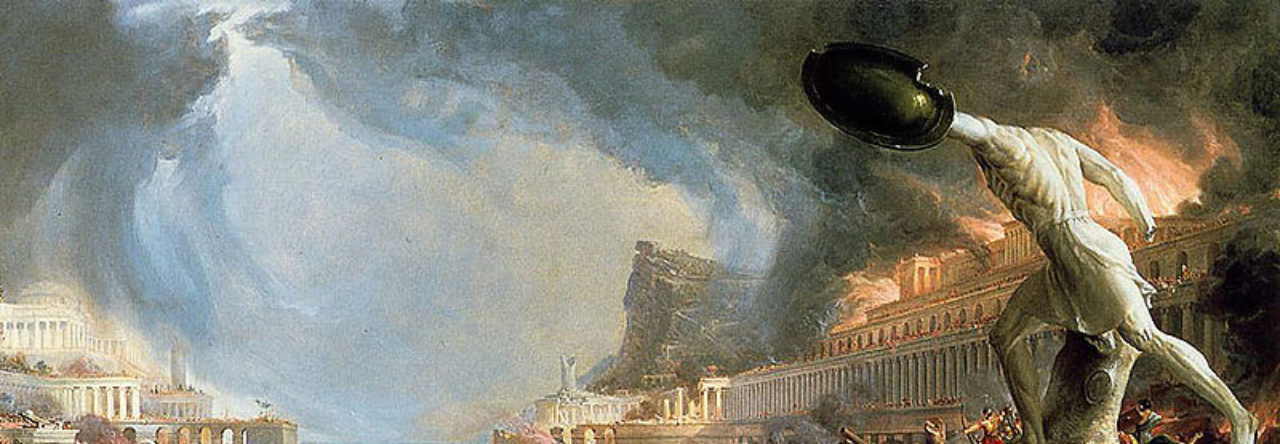In the aftermath of the 1905 Russo-Japanese War, US president Teddy Roosevelt brought together negotiators from Russia and Japan to hammer out a peace. This was the first time the US was ever seen as an ‘honest broker’ in international relations. In 1919 President Wilson sailed to Paris with his 14 Points doing his level best to get the Europeans to negotiate an honorable peace. The wily Europeans outfoxed the rigid and moralizing Southerner in just about all the negotiations. Nevertheless, the US retained the aura of ‘honest broker’ until this century. I can’t say exactly when we lost it—probably when Colin Powell lied to the UN in testimony before the Second Iraqi War—but lost it we did. Somewhere in there we lost the aura of exceptional power we possessed by pissing away a metric shit-ton (yes, an American who can do metric!) of blood and treasure in the sands of Iraq and mountains of Afghanistan—and with that loss, we shot whatever credibility we retained right in the foot. But those, shall I say, are different discussions for a different day.
Lost auras being the one thing—at least we still got a chakra, right? (Ugly and poisoned though it may be.) It’s the second thing that grates the teeth at night: an everlasting chronicle of bullshit deeply eroding any sense of diplomatic norms that’s transfigured us into OG rogue nation. So, grab some popcorn, rewind the Wayback Machine and head back to 2014 cause I got a whopper to tell you.
It’s late summer of 2014 and a brushfire war is simmering between Russia and the Ukraine. The US and its European allies are eager to see the Ukraine join NATO. They bring Russia and the Ukraine together and pretty much force feed them the Minsk Accords. Then, over the course of the next eight years the NATO allies string the Russians along encouraging the Ukraine in its ever persistent demands to renegotiate the Minsk Accords.
Nota bene: yes, I write it as the Ukraine. I know the Ukrainians desire their benighted lot to be call Ukraine.
Do I care?
Not one iota.
It was always called the Ukraine—I mean, the Russians use the partitive genitive (don’t ask) when describing the Ukraine as a nation—and it will ever thus be called the Ukraine.
Now, it took the Russians—rarely gullible—a long time to figure out our stunning acts of “bad faith.” But “bad faith” it was. The US and its European allies had no intention of ever compelling the Ukraine to live up to its international agreements with Russia. They were only ever playing for time, waiting for the day they could present Ukrainian membership in NATO as a fait accompli, hoping for a démarche, a dénouement. Damned if we got war in its place.
But the forever-war nation ain’t gonna let a little war-war stop it, no, no, no! Once America sets a precedent it’s game on, bitches! So, in late May-early June 2025 the US negotiated directly with Iranian diplomats signaling that no military action was imminent. While negotiations were held, the US and Israel agreed on America logistical support for an Israeli attack on Iran. A week after Israel launched its first strikes against Iranian nuclear sites, the United States followed suit. Not only is this acting in “bad faith” it’s outright deceit, a line no nation should ever cross in the conduct of negotiations. It’s one thing to bring two sets of instructions to negotiations, one always needs a fall-back position. But deceit? WTF?
Twice then, the US has acted in “bad faith.” It’s at number three when the wise recognize a pattern, three also being proof of outright illegality in the conduct of international affairs, at least according to international and domestic law. So, there is that, you know?
Domestic law, you ask? How so?
“Young grasshopper,” says Master Po, “sit and I will tell you.” (Anyone who gets the reference wins a cookie.)
Treaties signed by the United States and ratified by the Senate are, in accordance with the 1920 Supreme Court ruling Missouri v Holland, the supreme law of the land.
Skeptical-like, you query, “what treaty did we violate, Sean Paul?”
Easy, the 1961 Vienna Convention on Diplomatic Relations. This treaty enshrined, in international and domestic law, a norm of diplomacy dating back 575 years to the city-state of Milan and its then ruler Francesco Sforza—a norm, or custom only violated three or four times in the last century it’s so sacred. So basic, so important is the principle of the personal sanctity of the negotiator, aka the diplomat, that it is respected by every nation on the goddamned planet.
It is the singular, fundamental law of diplomacy from which spring all the other elements of reciprocity evident in the conduct of international relations. And in typical American fashion, just days ago, we nuked that norm into oblivion when we in concert with Qatar and Israel arranged for an attack on credentialed Hamas negotiators.
I don’t have anything else to add except a few questions. Why would any nation enter into negotiations with us ever again? Who would be that stupid and reckless? And what, if anything, can ever be done to regain international trust? What I’ve detailed are fundamentally outrageous betrayals of diplomatic norms, norms developed over 500 years ago and used for centuries.
It’s not rocket sceince. Hell, it ain’t even algebra. Christ, it’s more basic than fractions. It should be easy to comprehend. And the behavior is so fucking counter-productive I would expect even the stupid to fathom.
I would be wrong.
P.S. And consequences,those things be bad, like ju-ju bee tree bad shit. Didnae take long, aye?
P.P.S. Oh, and by the way, this leads directly to the massive diversification away from petrodollar settlements, which gets us a fuckton closer to the end of the dollar as global reserve currency. That’s going to be one serious painful adjustment for Americans to make, domestic production notwithstanding.
If you’ve read this far, and you’ve read some of my articles and most if not all of Ian’s, then you might wish to Subscribe or donate. Ian has written over 3,500 posts, and the site, and Ian, need the money to keep the shop running. So please, consider it.

